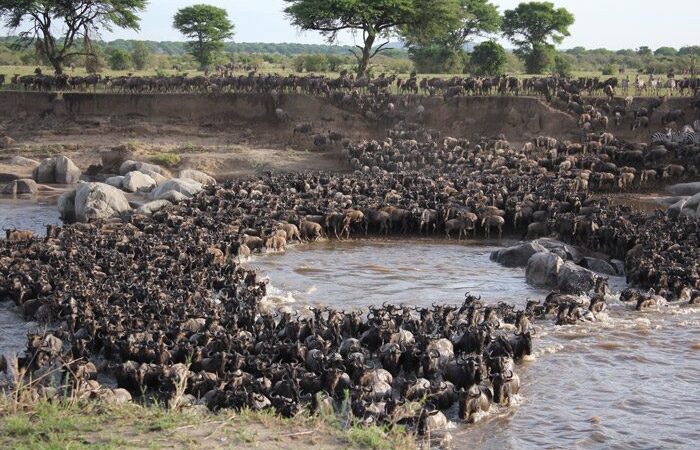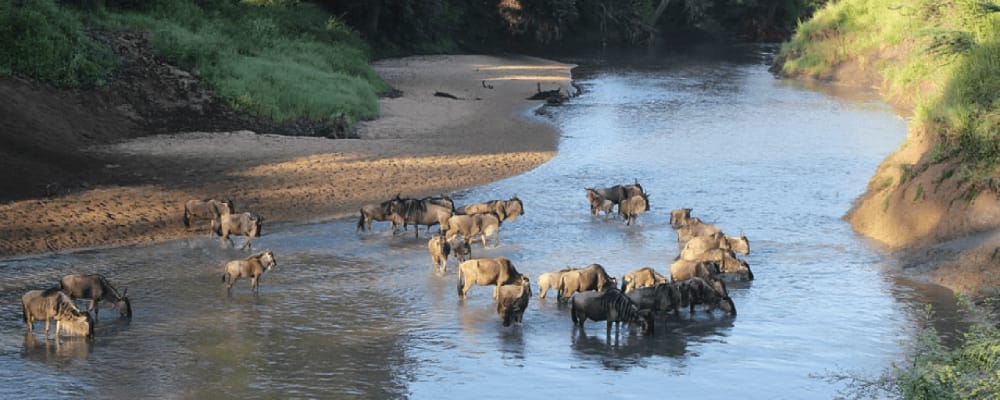Where to see the Great Migration from Kenya or Tanzania?

The Great Migration is a natural movement of hoofed animals in search of greener grazing grounds. The event features ungulates like wildebeest, zebra, and gazelle, though wildebeest are given all the credit. Every year, over 1.5 million wildebeest, alongside hundreds of thousands of zebras and gazelles, migrate driven by instincts to search for greener grazing grounds.
The migrating animals know no borders: they migrate from Tanzania to Kenya. Because this event involves two countries, nature lovers usually ask if they can witness it from the Tanzanian or Kenyan side. We are here to address this question. So, stay with us to the bottom line!
The Wildebeest Migration in the Serengeti (Tanzanian Side).
The migration spends much time in the Serengeti. It begins in the south of the park, with the calving season, and ends in the north with the fascinating Mara River crossings. Here’s a series of events of the migration while in the Serengeti.
Ndutu and Serengeti South (December – March).
Before commencing the journey, animals have a biological thing to do – giving birth to half a million calves. For this, they head to the southern plains, where they are sure that the greener grazing grounds (since the rainfall is back) can feed their newborns.
There are several reasons for this. The vast plains stretching from Ndutu to the Southern Serengeti produce nutrient-rich grass, which supports faster growth of calves. The plains have fertile soil derived from the volcanic ashes blown to Ndutu and the Southern Serengeti 2.5 million years ago.
What to see in Ndutu?
Thousands of young animals – The region teems with beautiful calves everywhere. You can watch them take their first step or run.
Predator-prey dynamics – Predators like lions, leopards, cheetahs, and hyenas move their camps close to the south to take any opportunity.
Striking scenery – This time comes with amazing scenery, ideal for gorgeous pictures. Photographers can catch shots of migrating animals with a beautiful backdrop.
Pro tip: Most lodges offer discounts and special offers during this season. The Serengeti Under Canvas, for example, offers a free day of stay if you stay in its tents for three days. Offer valid through January 31, 2026.
April – June (Seronera).
The journey begins with a trek to the central Serengeti via the Moru Kopjes. During this time, you can witness large herds sweeping the vast plains of Seronera. They settle in the grass-rich valley of Seronera before proceeding in a westward direction.
What to see in the Seronera?
Rutting season – Males show their strength as they fight for females. You can expect to see more bullfights between strong male bulls. Wondrously, the females have their choices despite many males fighting for them. So funny.
Pro tip: The central Serengeti is rich in wildlife, including the Big Five, big cats, and many other animals. So, there’s much to see and plenty of places to stay.
Western Corridor (late June – July)
As animals reach the Western Corridor, they face the first serious challenge before them – the Grumeti River. They have no other option but to cross it. These river crossings are not popular, but worth it.
What to see in the Western Corridor?
Grumeti River crossings – Herds after herds brave the Grumeti River to continue their course northwards. You can see Nile crocodiles nailing their prey underwater.

Pro tip: The Western Corridor is remote. Fewer visitors reach this region; therefore, you stand a chance to witness the magic on your own.
Northern Serengeti (August – September)
This is the moment many nature lovers wait for. The migrating animals arrive at the banks of this giant river, which hosts the fierce, hungry Nile crocodiles. Crossings start in late July with small herds entering the terrifying river. But between August and September, animals realize they have no option but to face the torrents and crocs.
What to see in the Northern Serengeti?
Mara River crossings – Animals cross the river on their own. If you’re lucky, you may spot a crossing in a day, but we recommend two or three days to maximize your chances.
Pro tip: Stay longer (at least 2-3 days) to increase your chances of seeing a crossing.
The Wildebeest Migration in the Masai Mara (Kenyan Side)
The Great Migration starts to enter the Masai Mara from September. In some seasons, they enter in August. However, the wildebeest migration in Kenya is short-lived because the animals start their journey back south between late October and November.
What to see in the Masai Mara?
Mara River crossings. Yes, of course. The Mara River transverses both Tanzania and Kenya. Therefore, some river crossings happen in the Masai Mara while others happen in the Serengeti. And there’s something to address here:
- The Mara River isn’t an exact border between Tanzania and Kenya. A single river crossing from the Serengeti doesn’t necessarily get the animals into Kenya. There’s more ground cover before crossing the border.
Large migration herds. By October, the herds are everywhere in the Masai Mara, including the Mara Triangle. So, this time, you can witness massive herds sweeping the Masai plains.
Pro tip: The Masai Mara is home to the Big Five and many other wildlife. It’s also compact hence perfect for short trips.
The bottom line
We all know it’s tempting to choose between Tanzania and Kenya. But our honest advice if you want to experience much of the Great Migration, Tanzania is the best option. But if your trip falls between September and October or you’re in a hurry, the Masai Mara is good for you.
Either way, we can help you trek this wonderful migration in our migration safaris. We offer customized itineraries to the Serengeti and the Masai Mara, and there’s an option to combine these fabulous destinations.
Are you ready to watch the sensational Mara River crossings in the north or the beautiful newborns in the south? Our expert safari planners are here to help you. Contact them for an instant free quote and any further information.


